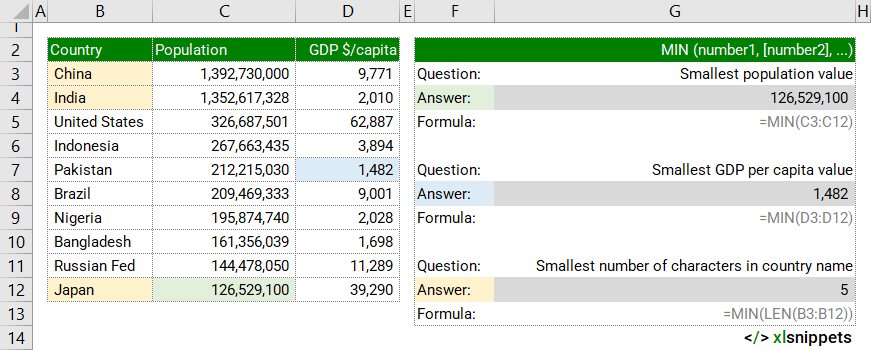Return the smallest value in a range of values
MIN(number1, [number2], ...)
MIN will assess up to 255 numbers to determine the smallest, including individual values (1,2,3), cell references (A1,A2,A3), ranges (A1:A3) or a mix of all three.
All numbers including negative values, percentages, dates, fractions, and times are assessed. Non-numeric values (e.g. text, TRUE/FALSE and empty cells) are ignored by the MIN function.
If the arguments contain no numbers, MIN returns zero. Error values cause errors.
MIN examples.
In the examples below, the MIN function is used to identify the smallest population or GDP per capita values or even (using an array formula) the smallest number of characters in a selection of text strings.
Use the MIN function to return the smallest value in a range of values.

Syntax
=MIN(number1, [number2], ...)
The MIN function consists of up to 255 arguments:
- number1. Required. The first number to assess.
- number2. Optional. The second number to assess.
- .... Optional. Additional numbers (up to 255) to assess.
Try it now!
- Enter your formulas into the grey cells.
Scope
MIN can be applied to cell references, ranges, named ranges, tables, constants and arrays.
|
=MIN(C3,C5,C7) |
|
=MIN(C3:C7) |
|
=MIN(myNamedRange) |
|
=MIN(Table1[ColumnName]) |
|
=MIN(number1,number2,number3,...) |
Caveats
The MIN function:
- can handle up to 255 individual arguments.
- will assess all numbers including negative values, percentages, dates, fractions, and times.
- will ignore text values, empty cells and TRUE and FALSE values.
- will trigger an error if the arguments contain errors.
- will return zero if the arguments contain no numbers.
- will automatically update if rows or columns within the range referenced in the formula are deleted. This prevents a #REF! error.
- will update to include added rows or columns (assuming they are within the range referenced in the formula).
Related Functions
- MAX: return the largest value in a range of values.
- LARGE: returns the k-th largest value in a data set.
- SMALL: returns the k-th smallest value in a data set
Functions Category



